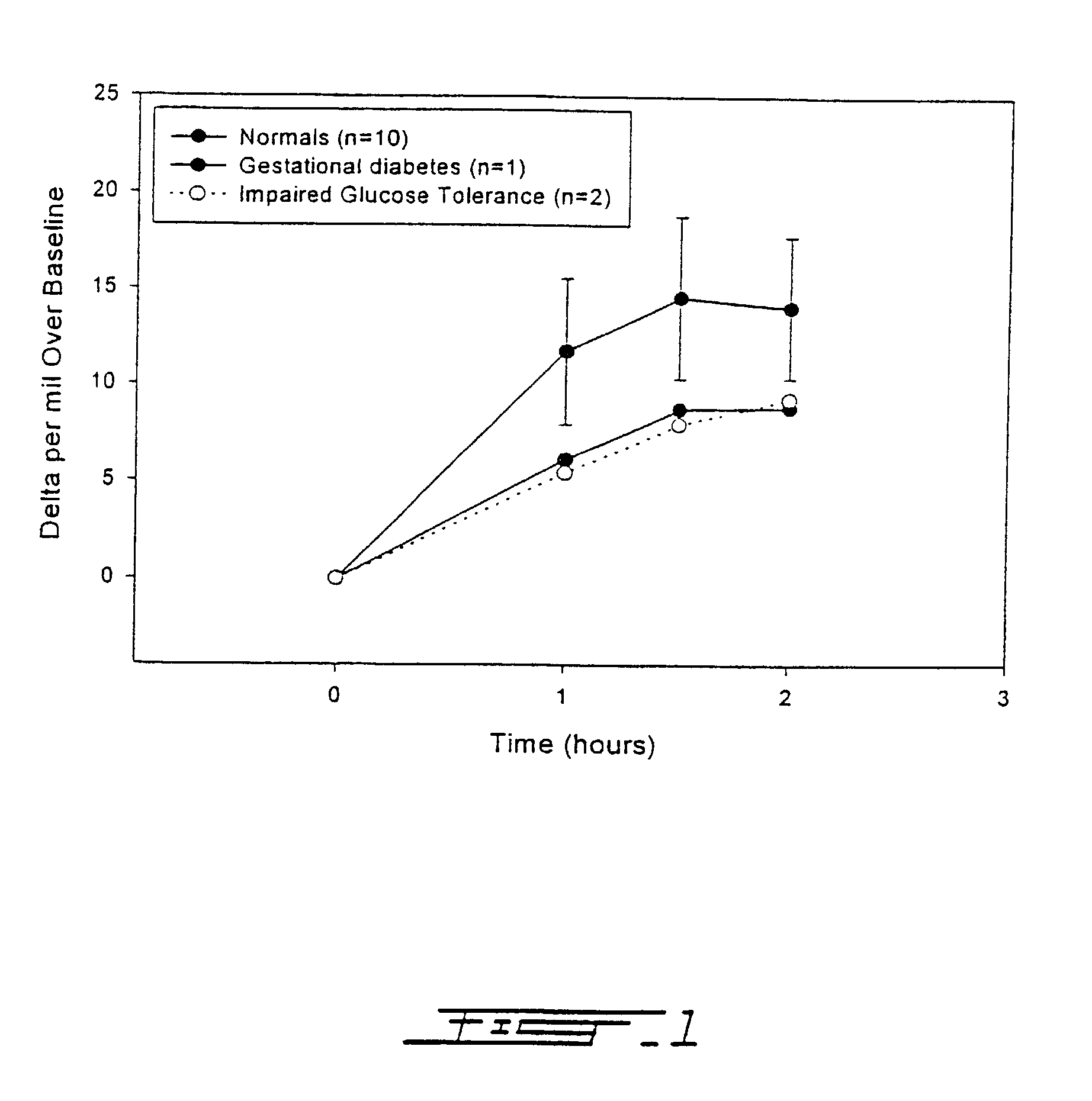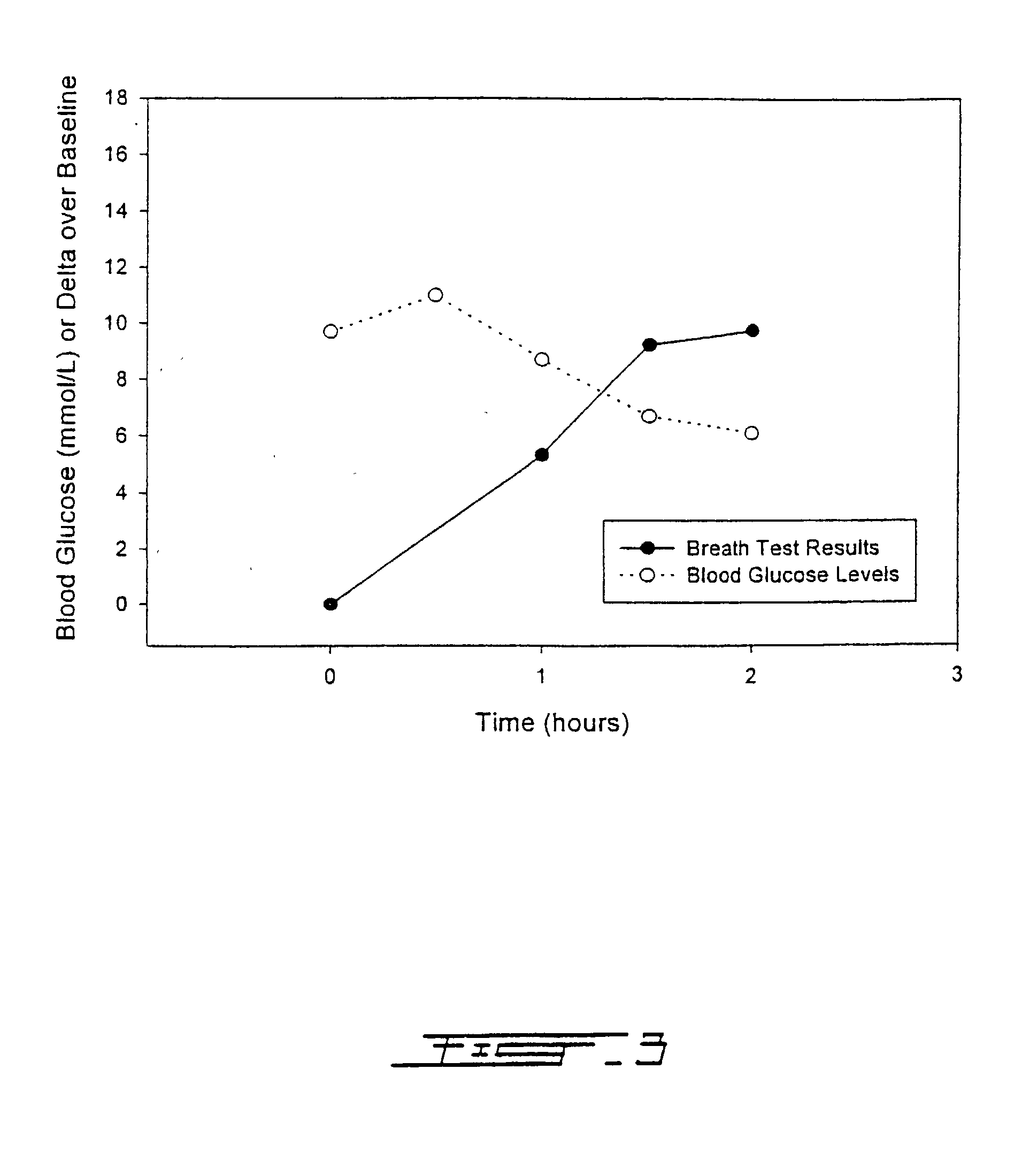13C glucose breath test for the diagnosis of diabetic indications and monitoring glycemic control
a breath test and glucose technology, applied in the field of 13c, can solve the problems of difficult control of test results, affecting the accuracy of blood glucose test results, and poor reproducibility, and achieve the effects of simple operation, low dose of glucose, and convenient us
- Summary
- Abstract
- Description
- Claims
- Application Information
AI Technical Summary
Benefits of technology
Problems solved by technology
Method used
Image
Examples
example 2
Breath Test Administration
[0060] Patients are given an exetainer tube with the screw cap removed. Using the straw, they are asked to breathe into the tube, exhaling normally, for 4 to 8 seconds. Next, each patient is instructed to drink a solution containing about 25 mg of uniformly labeled .sup.13C glucose in combination with about 15 g of unlabeled glucose in 100 mL of tap water. After 12 hours, the patients are given a new tube to breathe in as described above. The breath collection is then complete.
[0061] Storage and Shipping
[0062] Breath test tubes are typically labeled with the patient's name and identification number and shipped to an analytical laboratory for analysis. No refrigeration or special storage techniques are necessary.
example 3
Analytical Methodology
[0063] Breath specimens are analyzed by isotope ratio mass spectroscopy. NDIRS is also a preferred method to analyze breath test samples. Other methods known in the art may also be used.
[0064] Statistical Analysis
[0065] The sensitivity, specificity, positive and negative predictive values of the breath test are compared to that of the oral glucose tolerance test. Receiver operator characteristic curve analysis is performed to confirm the discrimination between type 2 diabetes or gestational diabetes and individuals with normal glucose metabolism.
example 4
Basis of the Method of IRMS
[0066] Isotope ratio mass spectroscopy (IRMS) is a highly precise method of analysis which is able to measure small samples (low nanogram amounts). For example, .sup.13C / .sup.12C ratios are determined on a mono-carbon molecule; CO.sub.2 gas. The CO.sub.2 gas can be directed to the spectrometer by means of a continuous flow IRMS (also called CF-IRMS).
[0067] The statistical combination of the isotopes of carbon (.sup.12C and .sup.13C) and oxygen (.sup.16O, .sup.17O, .sup.18O) to generate the CO.sub.2 molecules gives rise to the formation of various isotopomers whose molecular weights are 44, 45, and 46, respectively. Thus, for measuring carbon isotope ratios, three ion beams are generated and recorded in the IRMS, corresponding to the masses of the various isotopomers of CO.sub.2.
[0068] In order to obtain a high precision and a high accuracy, reference gases of absolutely known isotopic composition are used and a dual inlet system allows an alternative admis...
PUM
 Login to View More
Login to View More Abstract
Description
Claims
Application Information
 Login to View More
Login to View More - R&D
- Intellectual Property
- Life Sciences
- Materials
- Tech Scout
- Unparalleled Data Quality
- Higher Quality Content
- 60% Fewer Hallucinations
Browse by: Latest US Patents, China's latest patents, Technical Efficacy Thesaurus, Application Domain, Technology Topic, Popular Technical Reports.
© 2025 PatSnap. All rights reserved.Legal|Privacy policy|Modern Slavery Act Transparency Statement|Sitemap|About US| Contact US: help@patsnap.com



